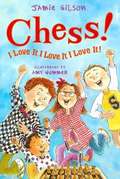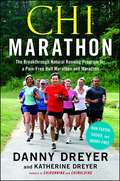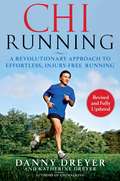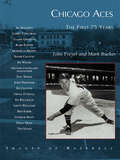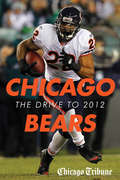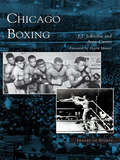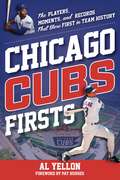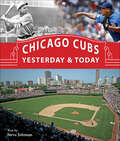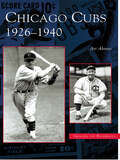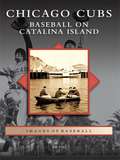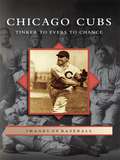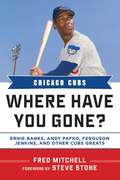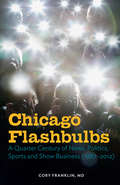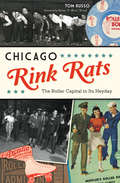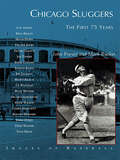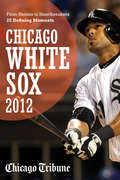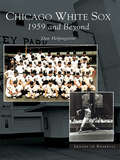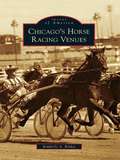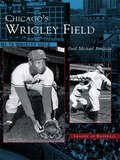- Table View
- List View
Chess! I Love It I Love It I Love It!
by Jamie GilsonWhen second-grader Richard and three other members of the Sumac School Chess Club competes in their first tournament, they each learn something about luck, concentration, and teamwork.
Cheyenne Frontier Days (Images of America)
by Starley Talbott Linda Graves FabianCheyenne Frontier DaysTM originated in 1897 after a few individuals conceived a signature event as a way to revive the thrilling incidents and pictures of life in the Old West. Their vision included a celebration that would bring visitors from all over the world to the capital city of Wyoming. From its beginnings, Cheyenne residents valued a rural lifestyle that inspired them to create a frontier festival. For more than a century, Cheyenne Frontier DaysTM has been the spirit, heart, and soul of the community and the cowboy way of life. Today, it has evolved into the world's largest outdoor rodeo and celebration of its kind.
Chi Marathon: The Breakthrough Natural Running Program for a Pain-Free Half Marathon and Marathon
by Katherine Dreyer Danny DreyerFROM THE AUTHORS OF THE BESTSELLING CHIRUNNING, A GAME-CHANGING TRAINING GUIDE FOR INJURY-FREE LONG-DISTANCE RUNNING In Chi Marathon, Danny Dreyer, creator of the revolutionary ChiRunning program, highly respected running coach, and accomplished distance runner, takes a whole-body approach to long-distance running--much like T'ai Chi--making ease and efficiency of movement the prime goal of one's training. Chi Marathon is the first book to focus not on building stamina first (though that is covered here) but on how to run all those miles without harming your body. A staggering 80 to 90 percent of marathoners face injuries during their training. This book debunks the myth that marathoners need to push through and beyond pain, and presents a technique-based plan for pain- and injury-free, high-performance half and full marathons. Chi Marathon also shows how to improve your performance by developing your own race-specific training plan tailored to your event, and will help you cross the finish line feeling strong no matter your age, body type, or running ability. * Run a marathon or half marathon free of pain and injury * Transform your racing with the training triad: form, conditioning, and mastery * Tap into your chi, an energy source more powerful and enduring than muscles * Teach your mind and body to work together as a team and master your event This is the book that distance runners have been waiting for. With Chi Marathon you can enjoy the run and feel confident no matter the distance.
Chi Nei Tsang: Chi Massage for the Vital Organs
by Mantak ChiaAn ancient Taoist system for detoxifying and rejuvenating the internal organs • Presents techniques to clear blockages in the body’s energy flow • Includes illustrated exercises to relieve common ailments, revitalize the organs, and enable readers to take charge of their own health and well-being • Focuses on the navel center, where negative emotions, stress, and illness accumulate The techniques of Chi Nei Tsang evolved in Asia during an era when few physicians were available and people had to know how to heal themselves. Many people today have symptoms that modern medicine is not able to cure because a physical source for the problem is not easily found. The energies of negative emotions, stress, and tension--all common in modern life--and the weight of past illness accumulate in the abdominal center, causing energy blockages and congestion. When this occurs, all vital functions stagnate and myriad problems arise. By practicing the techniques of Chi Nei Tsang, this stagnation is removed and the vital organs surrounding the navel center are detoxified and rejuvenated. Master Chia teaches readers how to avoid absorbing negative energies from others and take full charge of their health through the self-healing techniques of Chi Nei Tsang. He offers fully illustrated exercises that show how to detoxify the internal organs and clear the energy (chi) channels throughout the body. He also presents methods for balancing emotions, managing stress, and observing the body in order to recognize, ameliorate, and prevent maladies before they become a problem.
Chi Self-Massage: The Taoist Way of Rejuvenation
by Mantak ChiaEnergetic massage techniques that dispel negative emotions, relieve stress, and strengthen the senses, internal organs, and nervous system • Shows how Chi Massage employs one’s own internal energy to promote rejuvenation • Presents Chi Massage techniques for every organ and bodily system • Provides a daily practice routine that requires only 5 to 10 minutes to complete The Western concept of massage primarily concerns muscle manipulation. In the practice of Chi Massage, internal energy, or Chi, is manipulated to strengthen and rejuvenate the sense organs--eyes, ears, nose, tongue, teeth, and skin--and the internal organs. The Taoist techniques in this practice are more than 5,000 years old and, until very recently, were closely guarded secrets passed down from master to student with each master often knowing only a small part of the complete method. In Chi Self-Massage Master Mantak Chia pieces together the entire system of Chi Massage into a logical routine, revealing the methods used by Taoist masters to maintain their youthfulness. He explains the energetic theory behind Chi Massage and how negative emotions affect the organs and nervous system. By practicing the exercises outlined and following the daily routine that requires only 5 to 10 minutes to complete, readers can strengthen their senses--most notably vision, hearing, and taste--detoxify their internal organs and glands, help control negative emotions, relieve stress and constipation, and improve their complexion, teeth and gums, and overall stamina.
ChiRunning: A Revolutionary Approach to Effortless, Injury-Free Running
by Katherine Dreyer Danny DreyerMore than 24 million people run in the United States alone, but 65 percent will have to stop at least once this year because of injury. Still others will choose to run through the pain. But in this groundbreaking book, ultramarathoner Danny Dreyer teaches us the running technique he created to heal and prevent injuries and also to run faster, farther, and with much less effort at any age. ChiRunning employs the deep power reserves in the core muscles of the trunk, an approach that grows out of such disciplines as yoga, Pilates, and t'ai chi. This excellent step-by-step program offers training principles and is easily learned.
ChiWalking: Fitness Walking for Lifelong Health and Energy
by Katherine Dreyer Danny DreyerFrom the authors of the bestselling ChiRunning comes a revolutionary program that blends the health benefits of walking with the core principles of T'ai Chi to deliver maximum physical, mental, and spiritual fitness.The low-impact health benefits of walking have made it one of the most popular forms of daily exercise. Yet few people experience all the benefits that walking can offer. In ChiWalking, Danny and Katherine Dreyer, well-known walking and running coaches, teach the walking technique they created that transforms walking from a mundane means of locomotion into an intensely rewarding practice that enhances mental, emotional, and physical well-being. Similar to Pilates, yoga, and T'ai Chi, ChiWalking emphasizes body alignment and mindfulness while strengthening the core muscles of the body. The five mindful steps of the ChiWalking program will get anyone, regardless of age or athletic ability, into great shape from head to toe, inside and out. 1. Get aligned. Develop great posture and better balance. 2. Engage your core. Make back and knee pain disappear. 3. Create balance. Walk faster, farther, and with less effort. 4. Make a choice. Choose from a menu of twelve great walks such as the Cardio Walk, the Energizing Walk, or the Walking Meditation, to keep your exercise program fresh. 5. Move forward. Make walking any distance a mindful, enjoyable experience, whether you're a beginner or a seasoned walker.
Chicago Aces: The First 75 Years (Images of Baseball)
by Mark Rucker John FreyerAl Spalding was the first of many Chicago aces, leading the city's 1876 club to an inaugural National League Pennant with a 46-12 record and a whopping 528 innings pitched. Among the legendary pitchers to follow were Larry Corcoran, owner of two no-hitters with the White Stocking dynasty of the 1880s; Clark Griffith, who had six 20-win seasons in a row for a mediocre Orphans/Colts club in the 1890s; and "Rube" Foster, who dominated the Negro leagues of the early twentieth century. Also featured are Mordecai "Three Fingers" Brown, Eddie Cicotte, Ed Walsh, Grover Cleveland Alexander, and many others. In Chicago Aces: The First 75 Years, readers will discover the compelling stories of these great pitchers, highlighted by over 100 rare and striking images.
Chicago Bears: The Drive to 2012
by Chicago Tribune StaffThe Chicago Bears' 2011 season was over long before Major Wright's awkward landing on team captain Brian Urlacher's left knee, which ultimately required off-season surgery. Urlacher, writhing in pain on the Metrodome turf during the team's final game, was the final blow to the Bears' 2011 season, which had begun with a promising 7-3 record, ended with the insult of an 8-8 record, and serious injuries to the team's three biggest stars: Brian Urlacher, Jay Cutler, and Matt Forte.2011's disappointing end marked the fourth time in the previous five seasons that the Bears failed to make the playoffs. While the most direct cause of the Bears' late-season slump was quarterback Jay Cutler's freak thumb injury in Week 11, a lack of depth, adaptability, and success in the draft meant the lion's share of the blame fell on general manager Jerry Angelo. He, along with controversial offensive coordinator Mike Martz, were dismissed at season's end and replaced by long-time scouting director Phil Emery and former offensive line coach Mike Tice, respectively.While Bears onlookers expected a big move during free agency, Emery surprised everyone by making one of his first acquisitions the all-pro wide receiver Brandon Marshall. Marshall, who played with Cutler for the Denver Broncos, instantly became the most talented receiver ever to grace a Bears roster. The reunion continued when another former Bronco, Jeremy Bates, was brought in to be the quarterbacks coach, completing the triumvirate that helped Cutler and Marshall put up some of their best statistical seasons in Denver. It seemed like the Bears were finally surrounding Cutler with the level of talent he would need to thrive in the pass-happy NFL.Despite added weapons on the offensive end, many questions persisted as the off-season continued. Would Matt Forte's tense contract negotiations be solved before training camp or would a lengthy, damaging holdout follow? Would unheralded first-round pick Shea McClellin help the Bears defensive line issues or would Emery's gamble echo the many draft busts of his predecessor? Would the offensive line protect Cutler enough for him to take advantage of his new weapons? Would Brian Urlacher return at peak form following his gruesome knee injury and mysterious surgery?Your 2012 Chicago Bears is the complete guide to all of the 2012 Bears storylines and an in-depth wrap-up of all of the team's off-season moves. This book will make sure fans are caught up on anything missed over the summer and get them ready for a Bears season filled with high expectations. Edited by the award-winning journalists of the Chicago Tribune, the Chicago Bears' march to Super Bowl XLVII begins here.
Chicago Boxing (Images of Sports)
by David Mamet Sean Curtin J. J. JohnstonProfessor Mike Donovan, Battling Nelson-"The Durable Dane," and "Stockyards" Harold Smith-- their stories are as colorful as their names. Chicago's boxing history is as exciting and unpredictable as any prize fight within the ring. Some of the most memorable bouts--great, infamous or otherwise--took place in the city's clubs, parks and arenas, and Chicago has seen its share of champions and top contenders over the years. The Gans-McGovern fight in 1900--the "Big Fix"--set the sport back 25 years in Chicago. The "Long Count" between Tunney and Dempsey, in 1927, may still be the most controversial bout of all time. Chicago Boxing is a story not only of great boxers, but of the fans who embraced them, the promoters who made them big, and even a few mob bosses who made good on their talent.
Chicago Cubs Firsts: The Players, Moments, and Records That Were First in Team History (Sports Team Firsts)
by Al YellonIn the more than 140-year-history of the Chicago Cubs, fans have been treated to countless firsts — well-known things such as the first Cubs Black player (Ernie Banks), the first night game at Wrigley (August 9, 1988 vs. the Mets), the first to win a Gold Glove and Silver Slugger in the same year (Ryne Sandberg), and the first Cubs pitcher to win the Cy Young Award (Ferguson Jenkins). The list goes on.In Chicago Cubs Firsts, Al Yellon presents the stories behind those and other firsts in Cubs history in question-and-answer format. More than a mere trivia book, Yellon&’s collection includes substantive answers to the question of &“Who (or when) was the first…?&” on a variety of topics, many of which will surprise even seasoned fans of the North Siders.
Chicago Cubs Yesterday & Today
by Steve JohnsonOpen this book and explore the life and times of one of the most storied franchises in all of professional sports, the Chicago Cubs. Pairing historical black-and-white images with contemporary photographs of the modern game, Chicago Cubs Yesterday & Today celebrates more than a century of ups and downs in the history of the team and its legions of rabid fans. The book examines the ballparks, the teams, the players, and the colorful characters that have defined Cubs baseball and earned the loyalty of fans nationwide. Photos and text trace the history of the ball club from its origins in the 1870s to the latest accomplishments on the field, comparing the diamond heroes of today with those of yesteryear. In these pages you will encounter legendary batsmen from the Cubs roster, hitters like Cap Anson, Ernie Banks, Ron Santo, Ryne Sandberg, Sammy Sosa, and Derrek Lee. Youll see the dominating pitchers, from Mordecai "Three Finger" Brown to Carlos Zambrano. And youll meet the stars of the broadcast booth---Jack Brickhouse, Ronald Reagan, Harry Caray---and other behind-the-scenes figures who have played a revolutionary role in the development of the team and the game of baseball. A feast for Cubs fans and baseball aficionados, this journey through more than a hundred years of Chicago baseball encapsulates our national pastime at its best. It is the next best thing to a seat at Wrigley Field on a sunny summer afternoon.
Chicago Cubs: 1926-1940 (Images of Baseball)
by Art AhrensThe Chicago Cubs of the mid-1920s through 1940 were one of the most talented and exciting ball clubs the city ever produced. The Northsiders enjoyed 14 consecutive winning seasons and claimed the National League pennant four times (1929, 1932, 1935, and 1938), but fell to a dominant American League club in each World Series appearance. Four legendary baseball names led these Cub teams during this amazing stretch. Three eventually landed in Cooperstown (McCarthy, Hornsby, Hartnett), and many believe the fourth (Grimm) should have joined them. This was also the era when Cubs Park was transformed into Wrigley Field, under the guidance of Bill Veeck Jr., with its trademark bricks and ivy, hand-operated scoreboard, and outfield bleachers.
Chicago Cubs: Baseball on Catalina Island (Images of Baseball)
by Jim VittiIt's not quite like today's spring training: one might find a rookie ballplayer (nicknamed Hack) uprooting trees with his bare hands or a future president of the United States getting into a barroom brawl with some grizzled sportswriters. The team was the Chicago Cubs, and the place was Santa Catalina Island-through the Roaring Twenties, Great Depression, and World War II. William Wrigley owned both island and ballclub; from 1921 to 1951, they came together. There were movie stars, like Betty Grable and Marilyn Monroe. There were grand steamships, big bands, hopes and dreams, and World Series rings. It's Chicago Cubs: Baseball on Catalina Island, and it's a trip like no other.
Chicago Cubs: Tinker to Evers to Chance (Images of Baseball)
by Art AhrensIt has been a long time. Joe Tinker, Johnny Evers, and Frank Chance--that "trio of bear cubs" immortalized in poem and enshrined as a unit in Cooperstown--formed the core of a ball club that brought Chicago baseball fans backtoback World Series championships 100 years ago. And fans are still waiting for victory number three. Chicago Cubs: Tinker to Evers to Chance brings the reader back to the notsohalcyon days of spitball pitchers, insidethepark home runs, and an era when raucous fans lined the foul lines, often a little too close for comfort for the visiting ballplayers. Beginning in 1898 with the acquisition of a green Frank Chance and following the team's exploits through the 1916 season, the last for Joe Tinker in a Cubs uniform, this is the story of Wrigleyville's favorite tenants, before there was a Wrigleyville.
Chicago Cubs: Where Have You Gone? Ernie Banks, Andy Pafko, Ferguson Jenkins, and Other Cubs Greats (Where Have You Gone?)
by Steve Stone Fred MitchellIn this newly revised edition of Chicago Cubs: Where Have You Gone?, Chicago sportswriter Fred Mitchell catches up with over fifty former Cubs players--some of them famous, some of them obscure, all of them unforgettable. From Mr. Cub, Ernie Banks, to lesser known players such as Pete LaCock, avid fans of this long-suffering team will remember them for every heartbreak, every costly error and, yes, every glorious moment. Chicago Cubs: Where Have You Gone? serves as both a yearbook of unforgettable memories and an "alumni guide" for fans to find out where their heroes have gone since capturing their full attention at Wrigley Field. Readers will find out what happened after the gloves came off with such Cubs greats as Ferguson Jenkins, Andy Pafko, Dickie Noles, Billy Williams, Milt Pappas, Bobby Dernier, Lee Smith, Scott Sanderson, Shawon Dunston, Ed Lynch, Don Zimmer, Steve Trout, Ron Santo, Steve Stone, Kerry Wood, and so many more.
Chicago Flashbulbs: A Quarter Century of News, Politics, Sports, and Show Business (1987-2012)
by Cory Franklin"There is always a place for well-crafted, entertaining and informative essays and Chicago Flashbulbs fills that niche. Dr. Franklin's great enthusiasm and insights make these varied pieces both entertaining and memorable. His attention to detail in observing the human condition and his wry sense of humor will draw the reader in." - Howard Nearman, MD, MBA, Cascorbi Professor/Department Chair, Case Western university "Chicago Flashbulbs is filled with characters you want to read about: from hardworking teachers to a Princess; faded Hollywood legends, inspired physicians, rock stars and sports heroes. There are gripping accounts of the tragedy of wars, disease and man-made disasters as well as essays on the absurdity and humor of everyday life. The virtuous are celebrated while the pompous are revealed, as they should be." -Cynthia Kelly Conlon, JD, PhD, Adjunct Faculty, Northwestern university, School of education and Social Policy "These essays are custom-crafted for the news and nostalgia junkie which appeared in the op-ed page of the Chicago Tribune and in other publications. They are colorfully recounted stories of the high-born, the low-born and some who wished they had never been born. Readers will find themselves drawn into the subjects' lives." - Lt. Colonel Jim Nicholson, uS Army reserve (ret.), Former investigative reporter, Philadelphia Daily News, Author of Because No One Else
Chicago Rink Rats: The Roller Capital in Its Heyday
by Tom Russo Darius "D-Breez" StroudBy 1950, roller skating had emerged as the number-one participatory sport in America. Ironically, the war years launched the Golden Age of Roller Skating. Soldiers serving overseas pleaded for skates along with their usual requests for cigarettes and letters from home. Stateside, skating uplifted morale and kept war factory workers exercising. By the end of the decade, five thousand rinks operated across the country. Its epicenter: Chicago! And no one was left behind! The Blink Bats, a group of Braille Center skaters, held their own at the huge Broadway Armory rink. Meanwhile, the Swank drew South Side crowds to its knee-action floor and stocked jukebox. Eighteen celebrated rinks are now gone, but rinks that remain honor the traditions of the sport's glory years. Author Tom Russo scoured newspaper archives and interviewed skaters of the roller capital's heyday to reveal the enduring legacy of Chicago's rink rats.
Chicago Sluggers: The First 75 Years (Images of Baseball)
by Mark Rucker John FreyerThe Chicago White Stockings--later renamed the Cubs--won the inaugural National League Pennant in 1876 with a barrage of offensive numbers. Ross Barnes led the league at a .421 clip, and three other Chicago batters finished among the league's top five hitters. Even pitcher Al Spalding hit an impressive .312. Thus began the "northsiders" tradition of producing some of the major leagues' greatest sluggers--including "Cap" Anson, "Gabby" Hartnett, and "Hack" Wilson.The Chicago White Sox--still named the White Sox--won the inaugural American League Pennant in 1901, led by Fielder Jones' .311 average for a team built more around pitching than hitting--a team that won its first World Series title in 1906 with the nickname "The Hitless Wonders." But the "southsiders" also put up some lofty offensive numbers with the likes of Shoeless Joe Jackson and Eddie Collins.
Chicago White Sox 2012
by Chicago Tribune StaffThe 2012 season of the Chicago White Sox began with few expectations and even fewer hopes of success. As proof, team captain Paul Konerko toed traditionally shaky ground in Chicago by suggesting the White Sox didn't have to make the playoffs in order to have a successful season. (Even on the north side of town it's rare to see any member of the Chicago Cubs, perennial losers committed to a lengthy rebuilding process, downplay the significance or possibility of a playoff berth so forthrightly.)To the amazement of fans, division rivals, and baseball enthusiasts across the country, however, the White Sox spent much of the season atop the AL Central. Using strong contributions from three comeback player of the year candidates--Alex Rios, Adam Dunn, and Jake Peavy--as well as solid pitching and defense, the White Sox cobbled together enough winning streaks to be leading their division by the All-Star break.Rookie manager Robin Ventura, who had no previous managerial experience at any level, maintained a composure and focus throughout the season that was matched by his business-as-usual ballclub. While the season was filled with feel-good stories, it eventually was defined by a gut-wrenching slide in the final weeks of September when the White Sox squandered a three-game division lead with 3 weeks left in the season. Ultimately, the Detroit Tigers beat out the Sox for a playoff berth and the South Side boys of summer were forced to spend the fall thinking about what might have been.Comprised of articles from the Chicago Tribune's season-long coverage of the team, this book brings the heartbreaking story of the 2012 Chicago White Sox to readers with its insightful, award-winning sports reporting and commentary. Fans can relive the excitement of a team no one expected to compete and determine just what went wrong at season's end, as told through the trusted voices and beautiful photography of the Chicago Tribune staff.
Chicago White Sox: 1959 and Beyond (Images of Baseball)
by Dan HelpingstineThe Chicago White Sox are a charter member of the American League. Through a little over a century of baseball, they have accumulated a history of triumphs, scandals, and heartbreaking setbacks. The photographs in this book come from the collections of Leo Labau, Mark Fletcher, and Gerry Bilek, three lifelong White Sox fans. The images show dramatic, emotional, and light moments that could only happen in a baseball game played on the south side of Chicago. In these pages you will find showmen Bill Veeck and Harry Carey, the 1959 World Series, sluggers like Allen, Melton, Zisk, Gamble, and Kittle, and great pitchers like Peters, Horlen, and Wood. There are no world championships in this story, just the great moments of a team that hasgiven its fans great memories.
Chicago's Horse Racing Venues
by Kimberly A. RinkerThe popularity of horse racing in Chicago has yet to be rivaled in any other metropolitan area. Since the 1800s, the Windy City's enthusiasm for both harness and Thoroughbred racing led to 10 major racetracks being built in the Chicago area. Four of those raceways--Balmoral, Maywood, Hawthorne, and Arlington--are still racing and thriving today. From Washington Park, Lincoln Fields, and Worth Raceway on the city's South Side, to the Near West Side venues of Hawthorne Race Course and Sportsman's Park, to Arlington Park's northwest locale and Aurora Downs to the west, Chicago's racing community has enjoyed a long and sometimes scandalous history. Chicago's Horse Racing Venues provides insight into Chicago's rich racing history and a behind-the-scenes look at the people and horses involved.
Chicago's Wrigley Field (Images of Baseball)
by Paul Michael PetersonWrigley Field is the second oldest ballpark currently in use in the major leagues, but it ranks first in the hearts of Cubs fans. Rooting for the home team from the corner of Clark and Addison to small towns and city streets across the country, generations of Cubs' fans have made that summer pilgrimage to the home of Gabby Hartnett's "Homer in the gloamin'" that clinched the 1938 pennant, Hack Wilson's record 190 RBI season, Ernie Banks' 500th career home run, Sammy Sosa's 60 plus home run seasons, and Kerry Wood's 20-strikeout masterpiece. It was originally built as Wheeghman Park in 1914 to host the Chicago Whales of the upstart Federal League. The Cubs moved in two years later, and, with an 11-inning 7-6 victory over the rival Cincinnati Reds, one of the greatest traditions in all of American sports was established: National League baseball at Chicago's picturesque north side ballpark. Renamed Cubs Park in 1920 and finally Wrigley Field in 1926, the hallmark bricks and ivy, hand operated scoreboard, and high flying "W" (or, regrettably, "L") flag over Wrigley have become longstanding symbols of summertime in the city.
Chicharito Hernández (Superstars of Soccer SPANISH)
by Gustavo VazquezLlamado por el destino, con el futbol como herencia, Javier Hernández Balcázar nació para brillar en las canchas. Nieto e hijo de seleccionados nacionales que participaron en Copas del Mundo, el Chicharito representa a la nueva generación de futbolistas mexicanos cuyo terreno de juego es el mundo. Desde sus modestos orígenes en las fuerzas básicas de las Chivas de Guadalajara, hasta sus éxitos en el Manchester United, este libro sigue las andanzas de Hernández en su camino hacia la línea de fondo. El Chicharito es delantero de la vida, anotador de triunfos que todo México celebra.
Chicharito Hernández (Superstars of Soccer)
by Gustavo VazquezLlamado por el destino, con el futbol como herencia, Javier Hernández Balcázar nació para brillar en las canchas. Nieto e hijo de seleccionados nacionales que participaron en Copas del Mundo, el Chicharito representa a la nueva generación de futbolistas mexicanos cuyo terreno de juego es el mundo. Desde sus modestos orígenes en las fuerzas básicas de las Chivas de Guadalajara, hasta sus éxitos en el Manchester United, este libro sigue las andanzas de Hernández en su camino hacia la línea de fondo. El Chicharito es delantero de la vida, anotador de triunfos que todo México celebra.
